ECO mode ASTON MARTIN V8 VANTAGE 2010 User Guide
[x] Cancel search | Manufacturer: ASTON MARTIN, Model Year: 2010, Model line: V8 VANTAGE, Model: ASTON MARTIN V8 VANTAGE 2010Pages: 947, PDF Size: 43.21 MB
Page 826 of 947
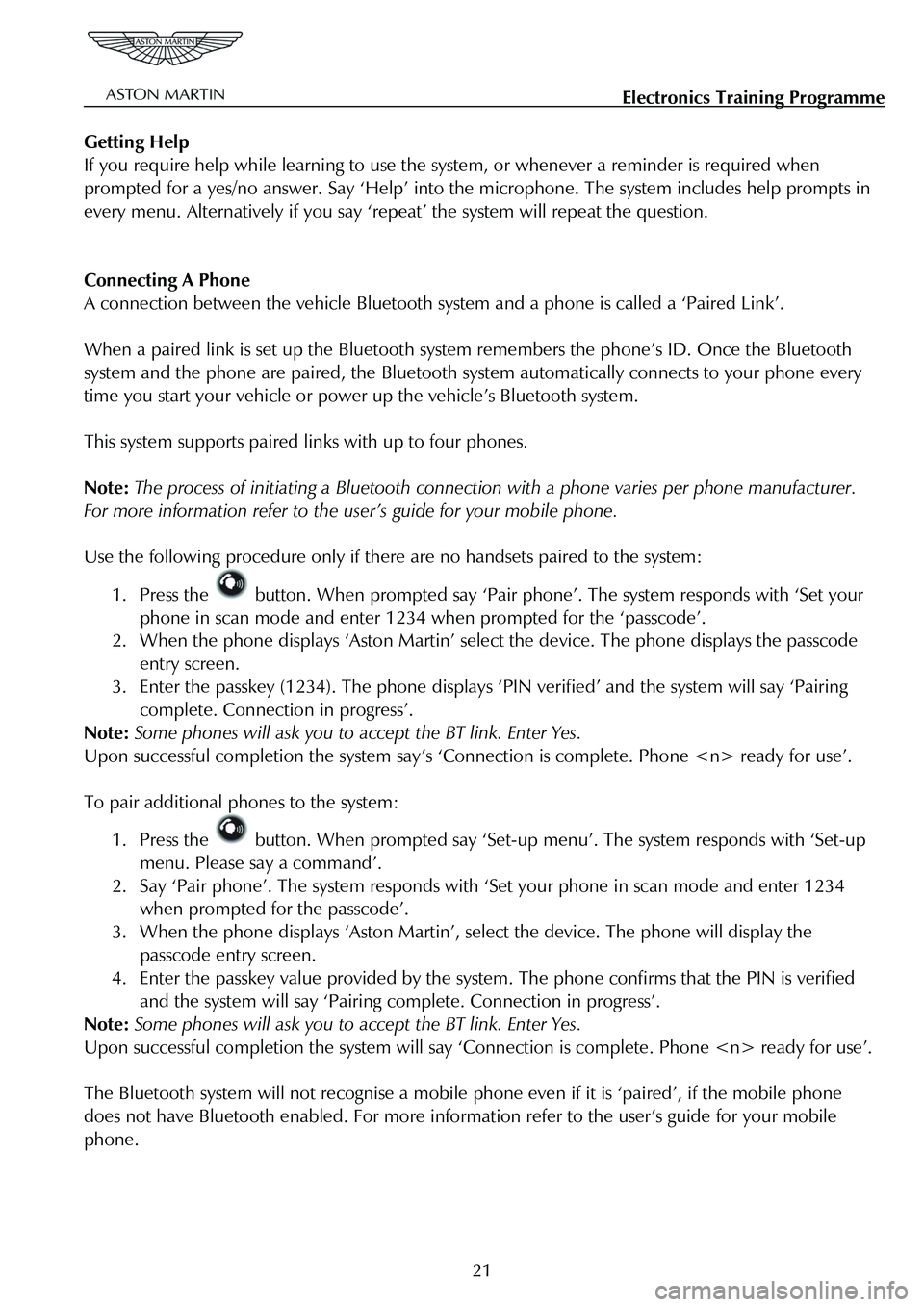
Electronics Training Programme
Getting Help
If you require help while learning to use the system, or whenever a reminder is required when
prompted for a yes/no answer. Say ‘Help’ into t he microphone. The system includes help prompts in
every menu. Alternatively if you say ‘repea t’ the system will repeat the question.
Connecting A Phone
A connection between the vehicle Bluetooth syst em and a phone is called a ‘Paired Link’.
When a paired link is set up the Bluetooth system remembers the phone’s ID. Once the Bluetooth
system and the phone are paired, the Bluetooth system automatically connects to your phone every
time you start your vehicle or powe r up the vehicle’s Bluetooth system.
This system supports paired links with up to four phones.
Note: The process of initiating a Bluetooth connection with a phone varies per phone manufacturer.
For more information refer to the user’s guide for your mobile phone.
Use the following procedure only if there are no handsets paired to the system:
1. Press the button. When prompted say ‘Pair phone’. The system responds with ‘Set your
phone in scan mode and enter 1234 when prompted for the ‘passcode’.
2. When the phone displays ‘Aston Martin’ sele ct the device. The phone displays the passcode
entry screen.
3. Enter the passkey (1234). The phone displays ‘P IN verified’ and the system will say ‘Pairing
complete. Connection in progress’.
Note: Some phones will ask you to a ccept the BT link. Enter Yes.
Upon successful completion the system say’s ‘Co nnection is complete. Phone
To pair additional phones to the system:
1. Press the button. When prompted say ‘Set-up menu’. The system responds with ‘Set-up
menu. Please say a command’.
2. Say ‘Pair phone’. The system responds with ‘Set your phone in scan mode and enter 1234
when prompted for the passcode’.
3. When the phone displays ‘Aston Martin’, select the device. The phone will display the
passcode entry screen.
4. Enter the passkey value provided by the system . The phone confirms that the PIN is verified
and the system will say ‘Pairing complete. Connection in progress’.
Note: Some phones will ask you to a ccept the BT link. Enter Yes.
Upon successful completion the sy stem will say ‘Connection is complete. Phone
The Bluetooth system will not recognise a mobile p hone even if it is ‘paired’, if the mobile phone
does not have Bluetooth enabled. For more information refer to the user’s guide for your mobile
phone.
21
Page 834 of 947
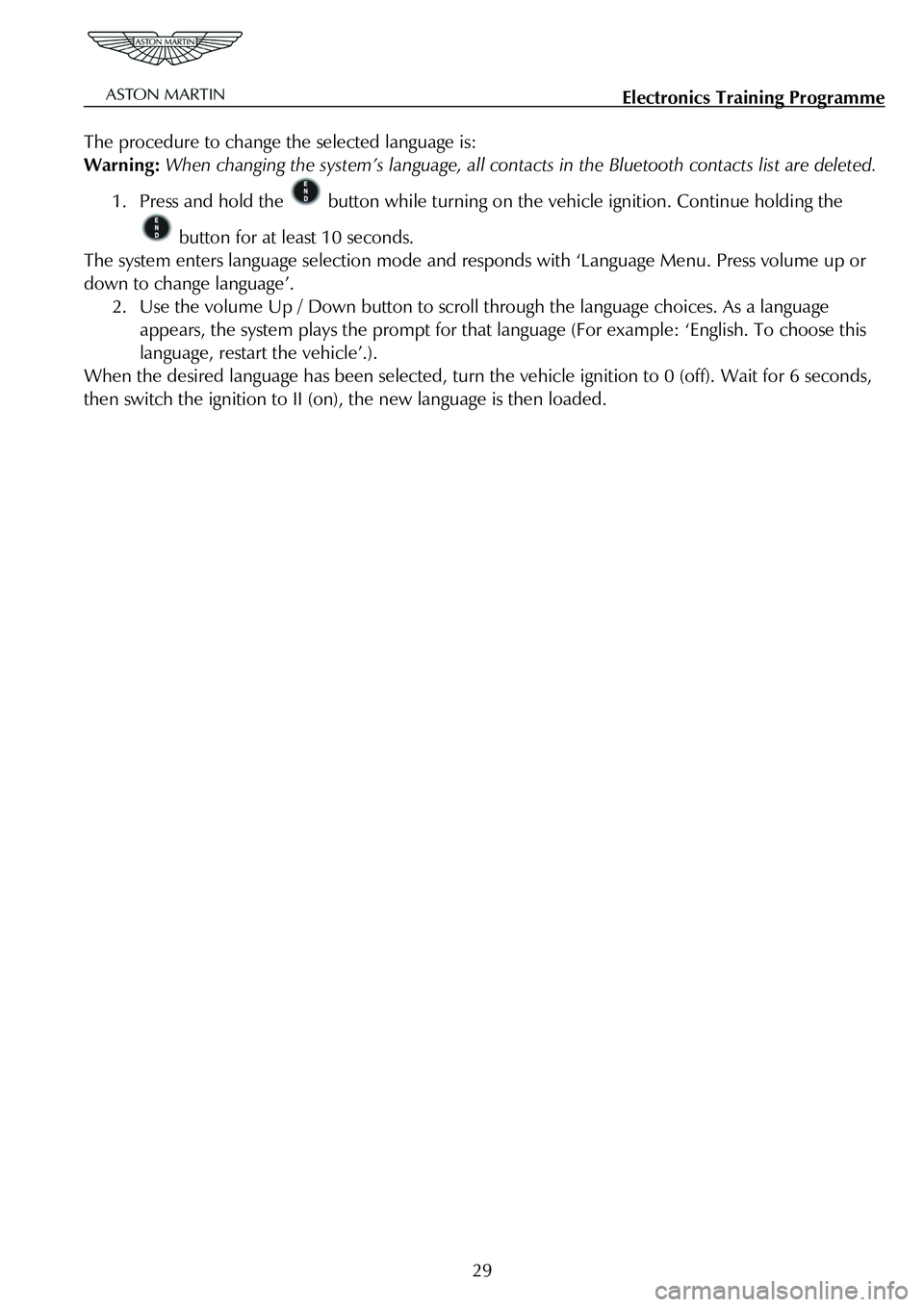
Electronics Training Programme
The procedure to change the selected language is:
Warning: When changing the system’s language, all contac ts in the Bluetooth contacts list are deleted.
1. Press and hold the button while turning on the vehicle ignition. Continue holding the
button for at least 10 seconds.
The system enters language selection mode and re sponds with ‘Language Menu. Press volume up or
down to change language’.
2. Use the volume Up / Down button to scroll through the language choices. As a language appears, the system plays the prompt for that la nguage (For example: ‘English. To choose this
language, restart the vehicle’.).
When the desired language has been selected, turn t he vehicle ignition to 0 (off). Wait for 6 seconds,
then switch the ignition to II (on), the new language is then loaded.
29
Page 854 of 947
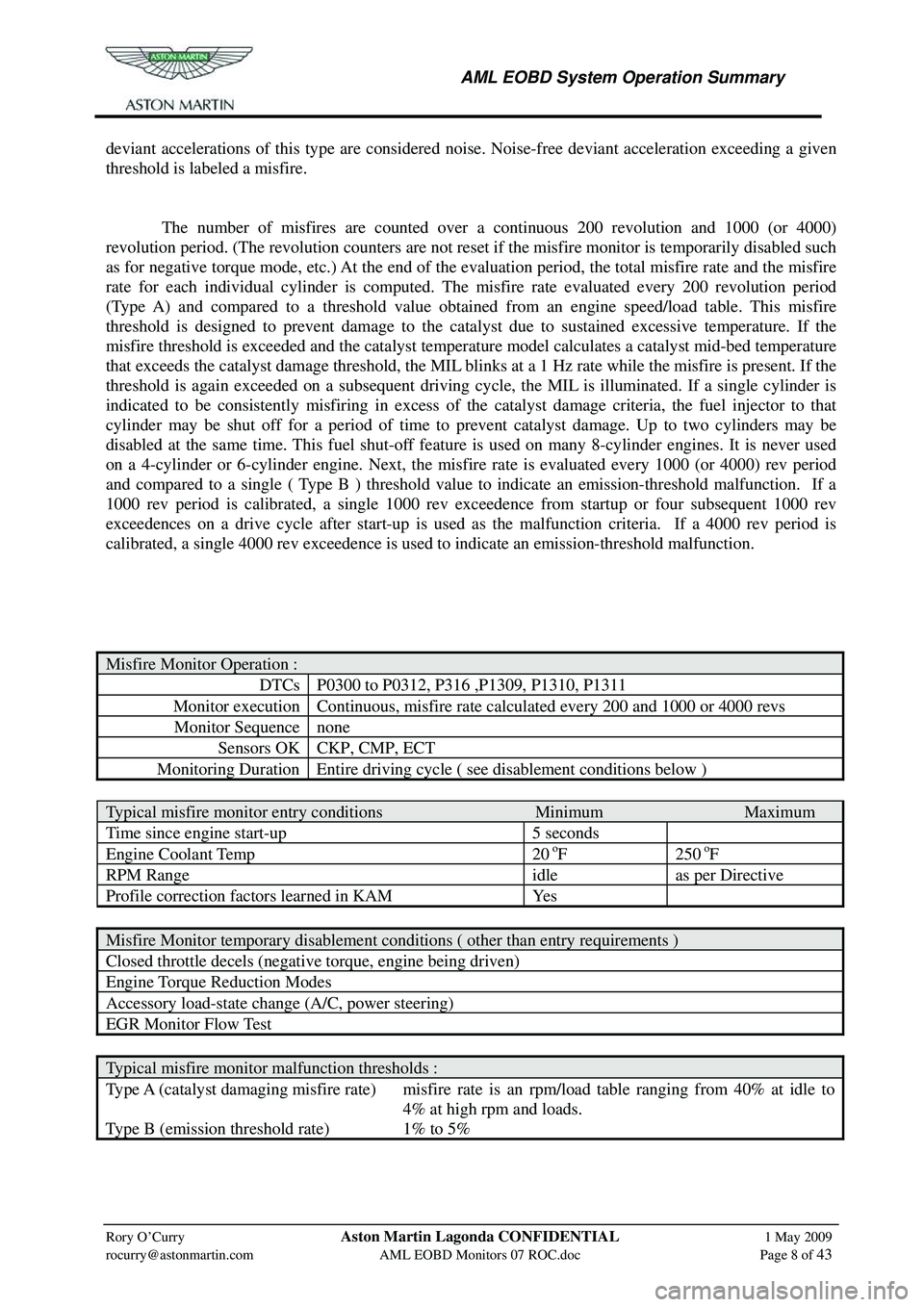
AML EOBD System Operation Summary
Rory O’Curry Aston Martin Lagonda CONFIDENTIAL 1 May 2009
[email protected] AML EOBD Monitors 07 ROC.doc Page 8 of 43
deviant accelerations of this type are considered noise. Noise-free deviant acceleration exceeding a given
threshold is labeled a misfire.
The number of misfires are counted over a continuous 200 revolution and 1000 (or 4000)
revolution period. (The revolution counters are not reset if the misfire monitor is temporarily disabled such
as for negative torque mode, etc.) At the end of the evaluation period, the total misfire rate and the misfire
rate for each individual cylinder is computed. The misfire rate evaluated every 200 revolution period
(Type A) and compared to a threshold value obtaine d from an engine speed/load table. This misfire
threshold is designed to prevent damage to the cat alyst due to sustained excessive temperature. If the
misfire threshold is exceeded and the catalyst temperature model calculates a catalyst mid-bed temperature
that exceeds the catalyst damage threshold, the MIL blinks at a 1 Hz rate while the misfire is present. If the
threshold is again exceeded on a subsequent driving cy cle, the MIL is illuminated. If a single cylinder is
indicated to be consistently misfiring in excess of the catalyst damage criteria, the fuel injector to that
cylinder may be shut off for a period of time to pr event catalyst damage. Up to two cylinders may be
disabled at the same time. This fuel shut-off feature is used on many 8-cylinder engines. It is never used
on a 4-cylinder or 6-cylinder engine. Next, the misf ire rate is evaluated every 1000 (or 4000) rev period
and compared to a single ( Type B ) threshold value to indicate an emission-threshold malfunction. If a
1000 rev period is calibrated, a single 1000 rev exceedence from startup or four subsequent 1000 rev
exceedences on a drive cycle after start-up is used as the malfunction criteria. If a 4000 rev period is
calibrated, a single 4000 rev exceedence is used to indicate an emission-threshold malfunction.
Misfire Monitor Operation :
DTCs P0300 to P0312, P316 ,P1309, P1310, P1311
Monitor execution Continuous, misfire rate calculated every 200 and 1000 or 4000 revs
Monitor Sequence none
Sensors OK CKP, CMP, ECT
Monitoring Duration Entire driving cycle ( see disablement conditions below )
Typical misfire monitor entry conditions Minimum Maximum
Time since engine start-up 5 seconds
Engine Coolant Temp 20 oF 250 oF
RPM Range idle as per Directive
Profile correction factors learned in KAM Yes
Misfire Monitor temporary disablement conditions ( other than entry requirements )
Closed throttle decels (negative torque, engine being driven)
Engine Torque Reduction Modes
Accessory load-state change (A/C, power steering)
EGR Monitor Flow Test
Typical misfire monitor malfunction thresholds :
Type A (catalyst damaging misfire rate) misfire rate is an rpm/load table ranging from 40% at idle to
4% at high rpm and loads.
Type B (emission threshold rate) 1% to 5%
Page 869 of 947
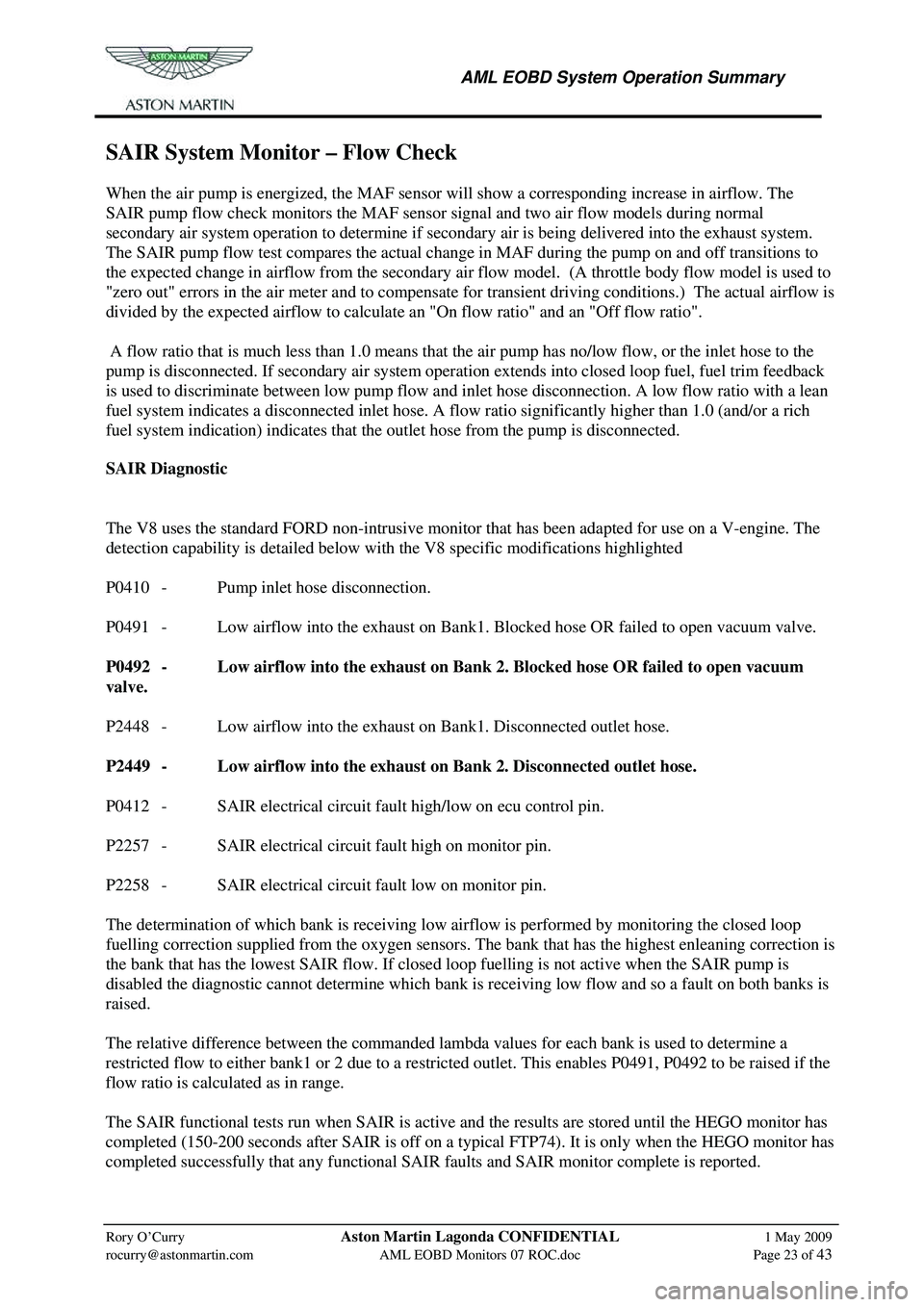
AML EOBD System Operation Summary
Rory O’Curry Aston Martin Lagonda CONFIDENTIAL 1 May 2009
[email protected] AML EOBD Monitors 07 ROC.doc Page 23 of 43
SAIR System Monitor – Flow Check
When the air pump is energized, the MAF sensor will show a corresponding increase in airflow. The
SAIR pump flow check monitors the MAF sensor signal and two air flow models during normal
secondary air system operation to determine if secondary air is being delivered into the exhaust system.
The SAIR pump flow test compares the actual change in MAF during the pump on and off transitions to
the expected change in airflow from the secondary air fl ow model. (A throttle body flow model is used to
"zero out" errors in the air meter and to compensate fo r transient driving conditions.) The actual airflow is
divided by the expected airflow to calculate an "On flow ratio" and an "Off flow ratio".
A flow ratio that is much less than 1.0 means that the air pump has no/low flow, or the inlet hose to the
pump is disconnected. If secondary air system operation ex tends into closed loop fuel, fuel trim feedback
is used to discriminate between low pump flow and in let hose disconnection. A low flow ratio with a lean
fuel system indicates a disconnected inlet hose. A flow ratio significantly higher than 1.0 (and/or a rich
fuel system indication) indicates that th e outlet hose from the pump is disconnected.
SAIR Diagnostic
The V8 uses the standard FORD non-intrusive monitor that has been adapted for use on a V-engine. The
detection capability is detailed below with the V8 specific modifications highlighted
P0410 - Pump inlet hose disconnection.
P0491 - Low airflow into the exhaust on Bank1. Blocked hose OR failed to open vacuum valve.
P0492 - Low airflow into the exhaust on Bank 2. Blocked hose OR failed to open vacuum
valve.
P2448 - Low airflow into the exhaust on Bank1. Disconnected outlet hose.
P2449 - Low airflow into the exhaust on Bank 2. Disconnected outlet hose.
P0412 - SAIR electrical circuit fault high/low on ecu control pin.
P2257 - SAIR electrical circuit fault high on monitor pin.
P2258 - SAIR electrical circuit fault low on monitor pin.
The determination of which bank is receiving low ai rflow is performed by monitoring the closed loop
fuelling correction supplied from the oxygen sensors. The bank that has the highest enleaning correction is
the bank that has the lowest SAIR flow. If closed loop fuelling is not active when the SAIR pump is
disabled the diagnostic cannot determ ine which bank is receiving low flow and so a fault on both banks is
raised.
The relative difference between the commanded lambda values for each bank is used to determine a
restricted flow to either bank1 or 2 due to a restricted outlet. This enables P0491, P0492 to be raised if the
flow ratio is calculated as in range.
The SAIR functional tests run when SAIR is active and the results are stored until the HEGO monitor has
completed (150-200 seconds after SAIR is off on a typical FTP74). It is only when the HEGO monitor has
completed successfully that any functional SAIR fa ults and SAIR monitor complete is reported.
Page 883 of 947
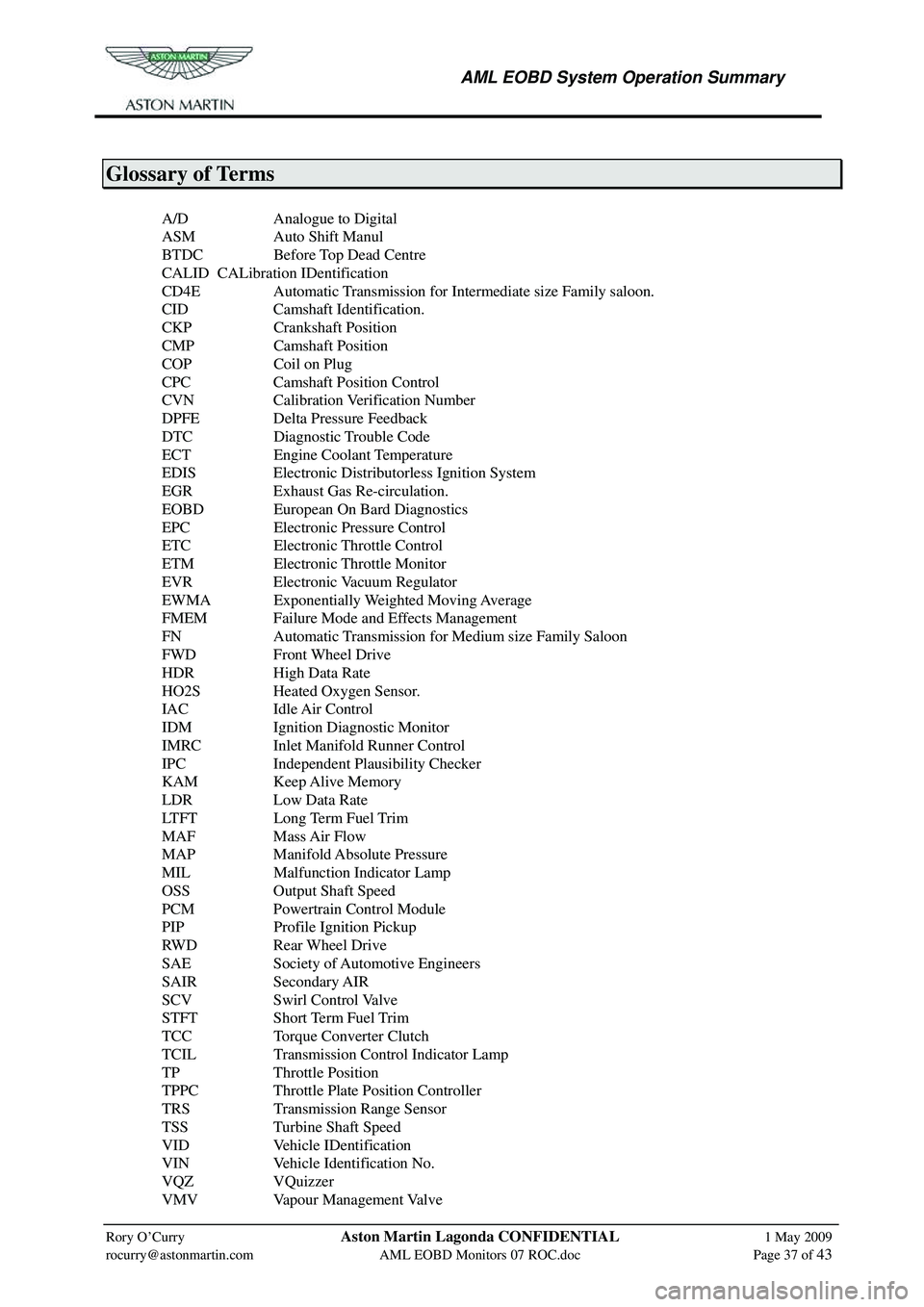
AML EOBD System Operation Summary
Rory O’Curry Aston Martin Lagonda CONFIDENTIAL 1 May 2009
[email protected] AML EOBD Monitors 07 ROC.doc Page 37 of 43
Glossary of Terms
A/D Analogue to Digital
ASM Auto Shift Manul
BTDC Before Top Dead Centre
CALID CALibration IDentification
CD4E Automatic Transmission for Intermediate size Family saloon.
CID Camshaft Identification.
CKP Crankshaft Position
CMP Camshaft Position
COP Coil on Plug
CPC Camshaft Position Control
CVN Calibration Verification Number
DPFE Delta Pressure Feedback
DTC Diagnostic Trouble Code
ECT Engine Coolant Temperature
EDIS Electronic Distributorless Ignition System
EGR Exhaust Gas Re-circulation.
EOBD European On Bard Diagnostics
EPC Electronic Pressure Control
ETC Electronic Throttle Control
ETM Electronic Throttle Monitor
EVR Electronic Vacuum Regulator
EWMA Exponentially Weighted Moving Average
FMEM Failure Mode and Effects Management
FN Automatic Transmission for Medium size Family Saloon
FWD Front Wheel Drive
HDR High Data Rate
HO2S Heated Oxygen Sensor.
IAC Idle Air Control
IDM Ignition Diagnostic Monitor
IMRC Inlet Manifold Runner Control
IPC Independent Plausibility Checker
KAM Keep Alive Memory
LDR Low Data Rate
LTFT Long Term Fuel Trim
MAF Mass Air Flow
MAP Manifold Absolute Pressure
MIL Malfunction Indicator Lamp
OSS Output Shaft Speed
PCM Powertrain Control Module
PIP Profile Ignition Pickup
RWD Rear Wheel Drive
SAE Society of Automotive Engineers
SAIR Secondary AIR
SCV Swirl Control Valve
STFT Short Term Fuel Trim
TCC Torque Converter Clutch
TCIL Transmission Control Indicator Lamp
TP Throttle Position
TPPC Throttle Plate Position Controller
TRS Transmission Range Sensor
TSS Turbine Shaft Speed
VID Vehicle IDentification
VIN Vehicle Identification No.
VQZ VQuizzer
VMV Vapour Management Valve
Page 890 of 947
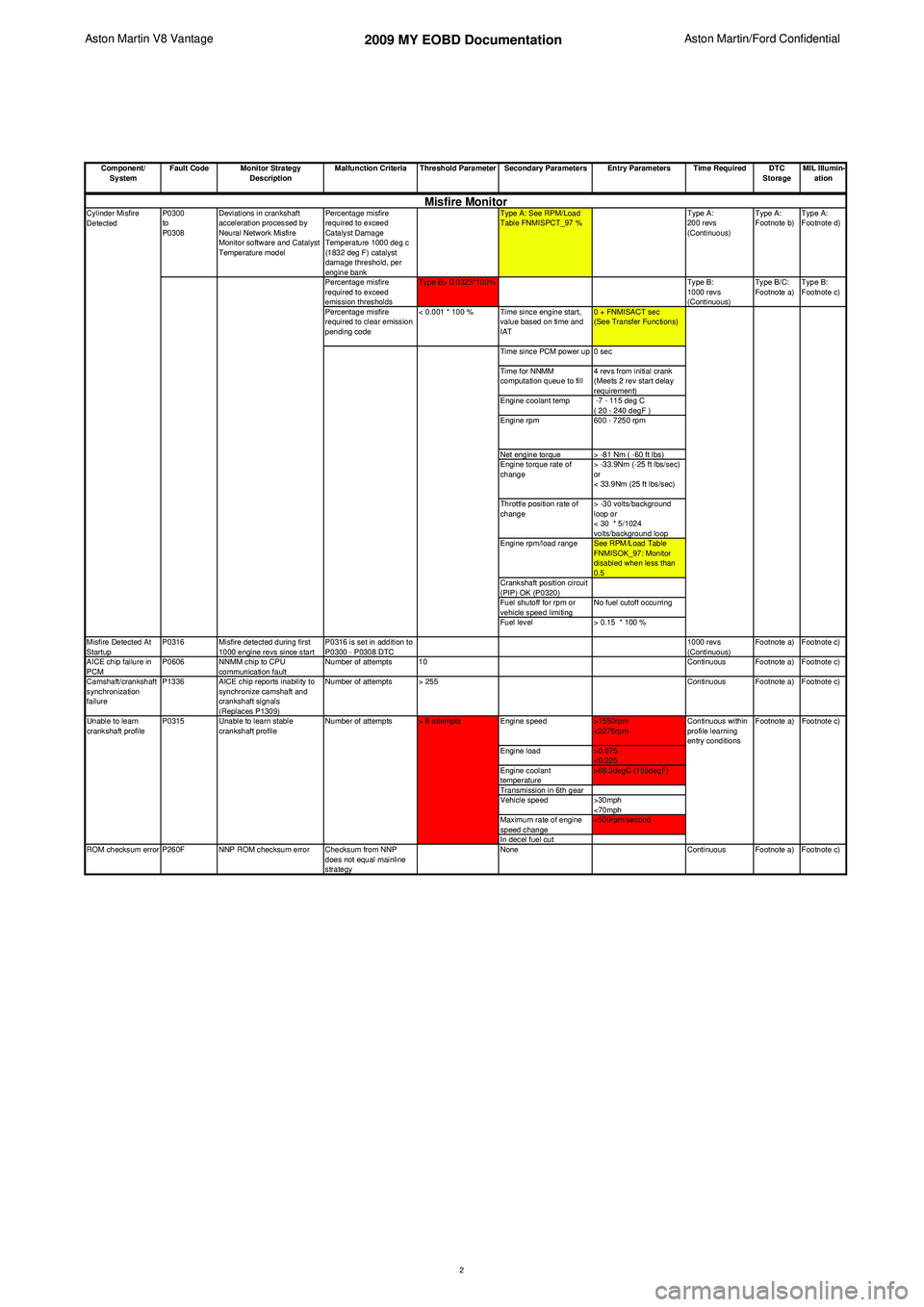
Aston Martin V8 Vantage 2009 MY EOBD DocumentationAston Martin/Ford Confidential
Component/ System Fault Code Monitor Strategy
Description Malfunction Criteria Threshold Parameter Secondary Parameters Entry Parameters Time Required DTC
StorageMIL Illumin-
ation
P0300
to
P0308 Deviations in crankshaft
acceleration processed by
Neural Network Misfire
Monitor software and Catalyst
Temperature model Percentage misfire
required to exceed
Catalyst Damage
Temperature 1000 deg c
(1832 deg F) catalyst
damage threshold, per
engine bank Type A: See RPM/Load
Table FNMISPCT_97 %
Type A:
200 revs
(Continuous)Type A:
Footnote b)
Type A:
Footnote d)
Percentage misfire
required to exceed
emission thresholds Type B> 0.0323*100% Type B:
1000 revs
(Continuous)Type B/C:
Footnote a)
Type B:
Footnote c)
Percentage misfire
required to clear emission
pending code < 0.001 * 100 % Time since engine start,
value based on time and
IAT 0 + FNMISACT sec
(See Transfer Functions)
Time since PCM power up 0 sec
Time for NNMM
computation queue to fill 4 revs from initial crank
(Meets 2 rev start delay
requirement)
Engine coolant temp -7 - 115 deg C ( 20 - 240 degF )
Engine rpm 600 - 7250 rpm
Net engine torque > -81 Nm ( -60 ft lbs)
Engine torque rate of
change > -33.9Nm (-25 ft lbs/sec)
or
< 33.9Nm (25 ft lbs/sec)
Throttle position rate of
change > -30 volts/background
loop or
< 30 * 5/1024
volts/background loop
Engine rpm/load range See RPM/Load Table FNMISOK_97: Monitor
disabled when less than
0.5
Crankshaft position circuit
(PIP) OK (P0320)
Fuel shutoff for rpm or
vehicle speed limiting No fuel cutoff occurring
Fuel level > 0.15 * 100 %
Misfire Detected At
Startup P0316 Misfire detected during first
1000 engine revs since start P0316 is set in addition to
P0300 - P0308 DTC 1000 revs
(Continuous)Footnote a) Footnote c)
AICE chip failure in
PCM P0606 NNMM chip to CPU
communication fault Number of attempts 10
Continuous Footnote a) Footnote c)
Camshaft/crankshaft
synchronization
failure P1336 AICE chip reports inability to
synchronize camshaft and
crankshaft signals
(Replaces P1309) Number of attempts > 255
Continuous Footnote a) Footnote c)
Engine speed >1550rpm
<2275rpm
Engine load >0.075
<0.225
Engine coolant
temperature >68.3degC (155degF)
Transmission in 6th gear
Vehicle speed >30mph
<70mph
Maximum rate of engine
speed change <500rpm/second
In decel fuel cut
ROM checksum error P260F NNP ROM checksum error Checksum from NNP does not equal mainline
strategyNone
Continuous Footnote a) Footnote c)
Cylinder Misfire
DetectedMisfire Monitor
Footnote c)
Unable to learn
crankshaft profile P0315 Unable to learn stable
crankshaft profile Number of attempts > 6 attempts Continuous within
profile learning
entry conditionsFootnote a)
2
Page 891 of 947
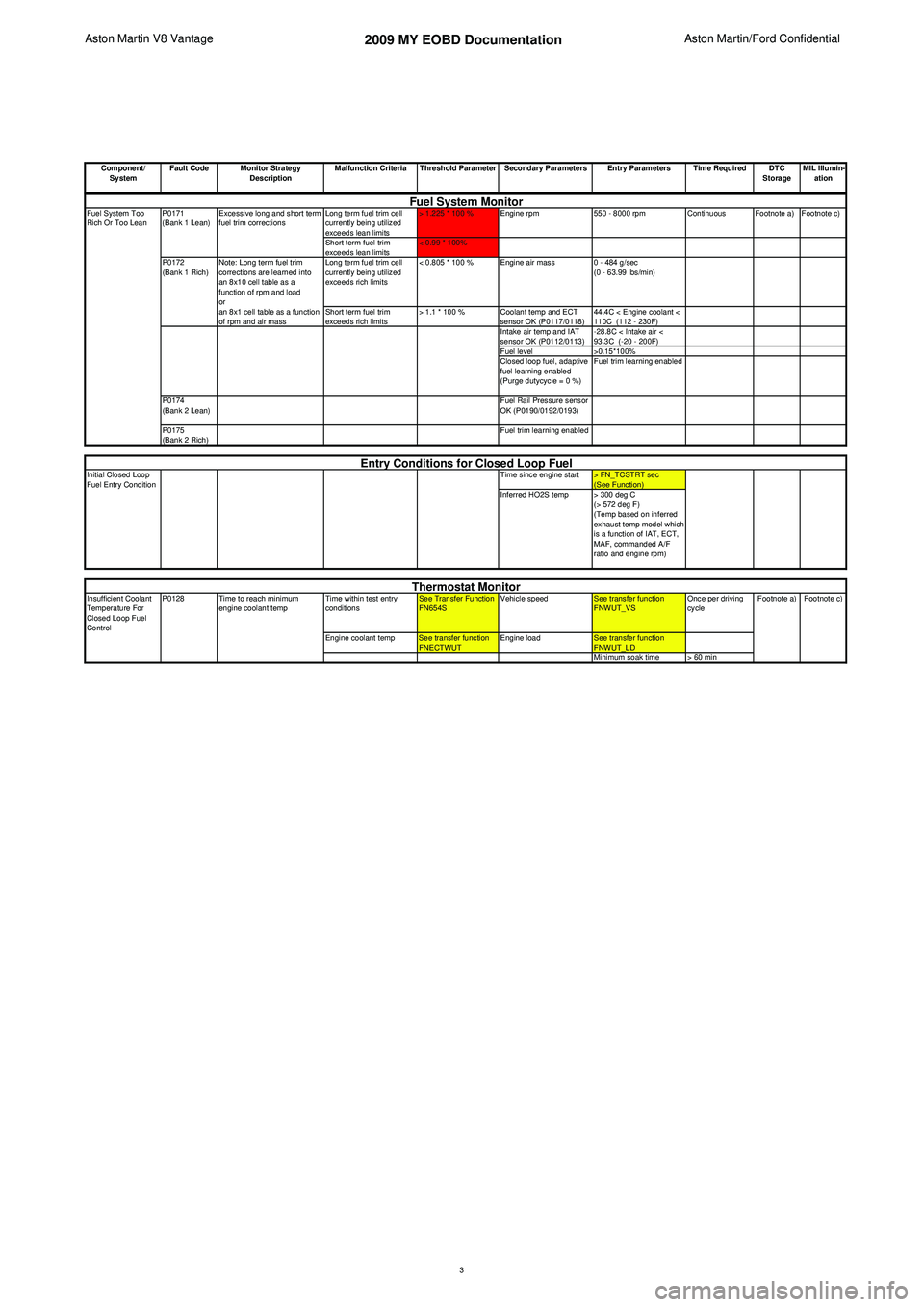
Aston Martin V8 Vantage 2009 MY EOBD DocumentationAston Martin/Ford Confidential
Component/ System Fault Code Monitor Strategy
Description Malfunction Criteria Threshold Parameter Secondary Parameters Entry Parameters Time Required DTC
StorageMIL Illumin-
ation
Long term fuel trim cell
currently being utilized
exceeds lean limits > 1.225 * 100 % Engine rpm
550 - 8000 rpmContinuous Footnote a) Footnote c)
Short term fuel trim
exceeds lean limits < 0.99 * 100%
Long term fuel trim cell
currently being utilized
exceeds rich limits < 0.805 * 100 % Engine air mass
0 - 484 g/sec
(0 - 63.99 lbs/min)
Short term fuel trim
exceeds rich limits > 1.1 * 100 % Coolant temp and ECT
sensor OK (P0117/0118) 44.4C < Engine coolant <
110C (112 - 230F)
Intake air temp and IAT
sensor OK (P0112/0113) -28.8C < Intake air <
93.3C (-20 - 200F)
Fuel level >0.15*100%
Closed loop fuel, adaptive
fuel learning enabled
(Purge dutycycle = 0 %) Fuel trim learning enabled
P0174
(Bank 2 Lean) Fuel Rail Pressure sensor
OK (P0190/0192/0193)
P0175
(Bank 2 Rich) Fuel trim learning enabled
Time since engine start > FN_TCSTRT sec
(See Function)
Inferred HO2S temp > 300 deg C (> 572 deg F)
(Temp based on inferred
exhaust temp model which
is a function of IAT, ECT,
MAF, commanded A/F
ratio and engine rpm)
Time within test entry
conditions See Transfer Function
FN654SVehicle speed
See transfer function
FNWUT_VS Once per driving
cycle
Engine coolant temp See transfer function FNECTWUTEngine load
See transfer function
FNWUT_LD
Minimum soak time > 60 min
Entry Conditions for Closed Loop Fuel
Thermostat MonitorInitial Closed Loop
Fuel Entry Condition Note: Long term fuel trim
corrections are learned into
an 8x10 cell table as a
function of rpm and load
or
an 8x1 cell table as a function
of rpm and air mass
P0172
(Bank 1 Rich)
Fuel System MonitorFuel System Too
Rich Or Too Lean
P0171
(Bank 1 Lean)Excessive long and short term
fuel trim corrections
Footnote c)
Insufficient Coolant
Temperature For
Closed Loop Fuel
Control P0128 Time to reach minimum
engine coolant temp Footnote a)
3
Page 892 of 947
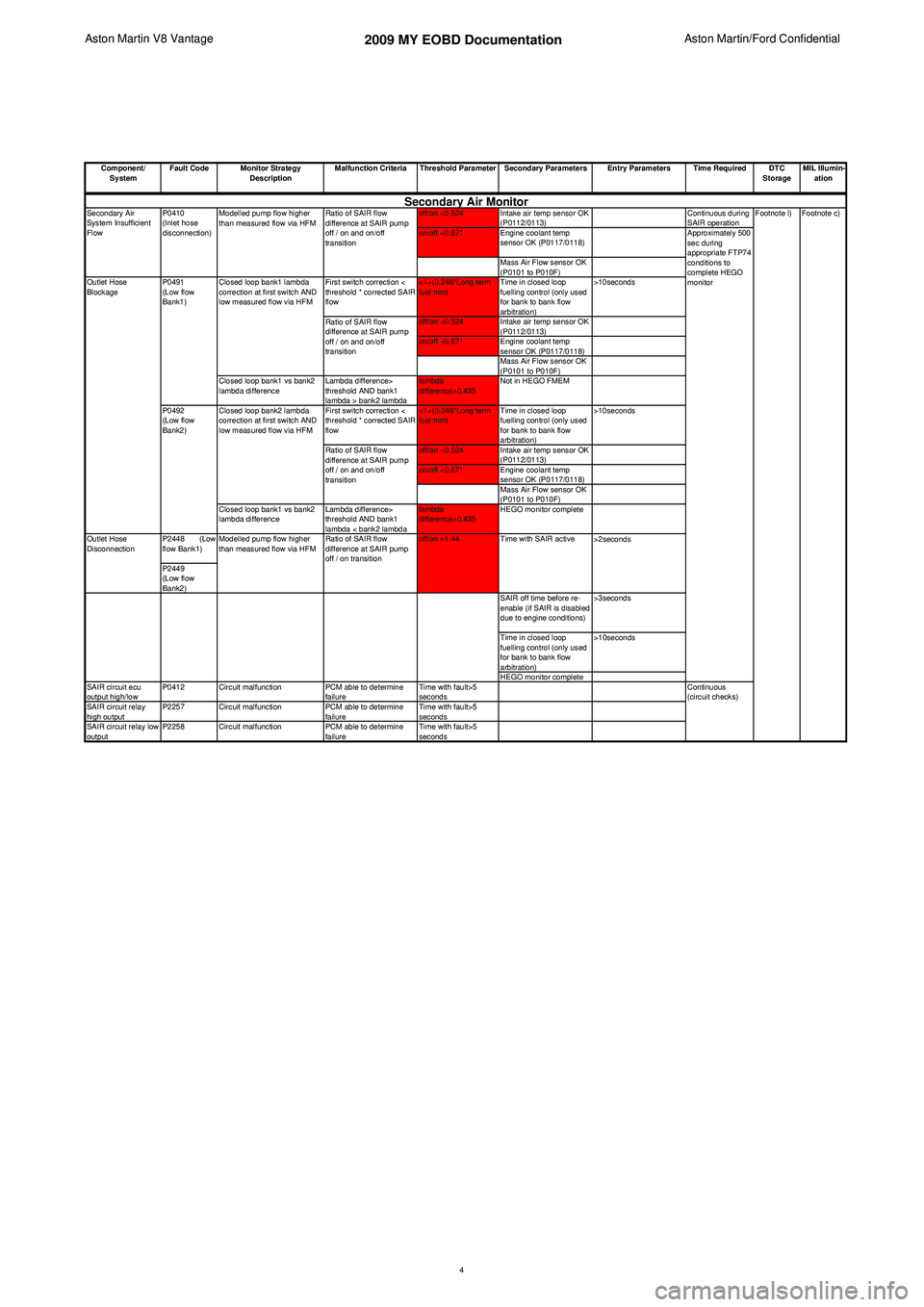
Aston Martin V8 Vantage 2009 MY EOBD DocumentationAston Martin/Ford Confidential
Component/ System Fault Code Monitor Strategy
Description Malfunction Criteria Threshold Parameter Secondary Parameters Entry Parameters Time Required DTC
StorageMIL Illumin-
ation
off/on <0.524 Intake air temp sensor OK (P0112/0113) Continuous during
SAIR operation
on/off <0.671 Engine coolant temp sensor OK (P0117/0118)
Mass Air Flow sensor OK
(P0101 to P010F)
First switch correction <
threshold * corrected SAIR
flow <1+(0.246*Long term
fuel trim)
Time in closed loop
fuelling control (only used
for bank to bank flow
arbitration) >10seconds
off/on <0.524 Intake air temp sensor OK (P0112/0113)
on/off <0.671 Engine coolant temp sensor OK (P0117/0118)
Mass Air Flow sensor OK
(P0101 to P010F)
Closed loop bank1 vs bank2
lambda difference Lambda difference>
threshold AND bank1
lambda > bank2 lambdalambda
difference>0.435
Not in HEGO FMEM
First switch correction <
threshold * corrected SAIR
flow <1+(0.246*Long term
fuel trim)
Time in closed loop
fuelling control (only used
for bank to bank flow
arbitration) >10seconds
off/on <0.524 Intake air temp sensor OK (P0112/0113)
on/off <0.671 Engine coolant temp sensor OK (P0117/0118)
Mass Air Flow sensor OK
(P0101 to P010F)
Closed loop bank1 vs bank2
lambda difference Lambda difference>
threshold AND bank1
lambda < bank2 lambdalambda
difference>0.435
HEGO monitor complete
P2448 (Low
flow Bank1)
P2449
(Low flow
Bank2) SAIR off time before re-
enable (if SAIR is disabled
due to engine conditions)>3seconds
Time in closed loop
fuelling control (only used
for bank to bank flow
arbitration) >10seconds
HEGO monitor complete
SAIR circuit ecu
output high/low P0412 Circuit malfunction
PCM able to determine
failure Time with fault>5
seconds
SAIR circuit relay
high output P2257 Circuit malfunction
PCM able to determine
failure Time with fault>5
seconds
SAIR circuit relay low
output P2258 Circuit malfunction
PCM able to determine
failure Time with fault>5
seconds
Ratio of SAIR flow
difference at SAIR pump
off / on and on/off
transition
Modelled pump flow higher
than measured flow via HFM
Ratio of SAIR flow
difference at SAIR pump
off / on and on/off
transition
Ratio of SAIR flow
difference at SAIR pump
off / on and on/off
transition
>2secondsFootnote c)
Approximately 500
sec during
appropriate FTP74
conditions to
complete HEGO
monitorSecondary Air Monitor
Modelled pump flow higher
than measured flow via HFM Ratio of SAIR flow
difference at SAIR pump
off / on transitionoff/on >1.44
Outlet Hose
Disconnection Footnote l)
Continuous
(circuit checks)
Outlet Hose
Blockage
P0492
(Low flow
Bank2)
P0410
(Inlet hose
disconnection)
Secondary Air
System Insufficient
Flow
Closed loop bank1 lambda
correction at first switch AND
low measured flow via HFM
Closed loop bank2 lambda
correction at first switch AND
low measured flow via HFM
P0491
(Low flow
Bank1)
Time with SAIR active
4
Page 895 of 947
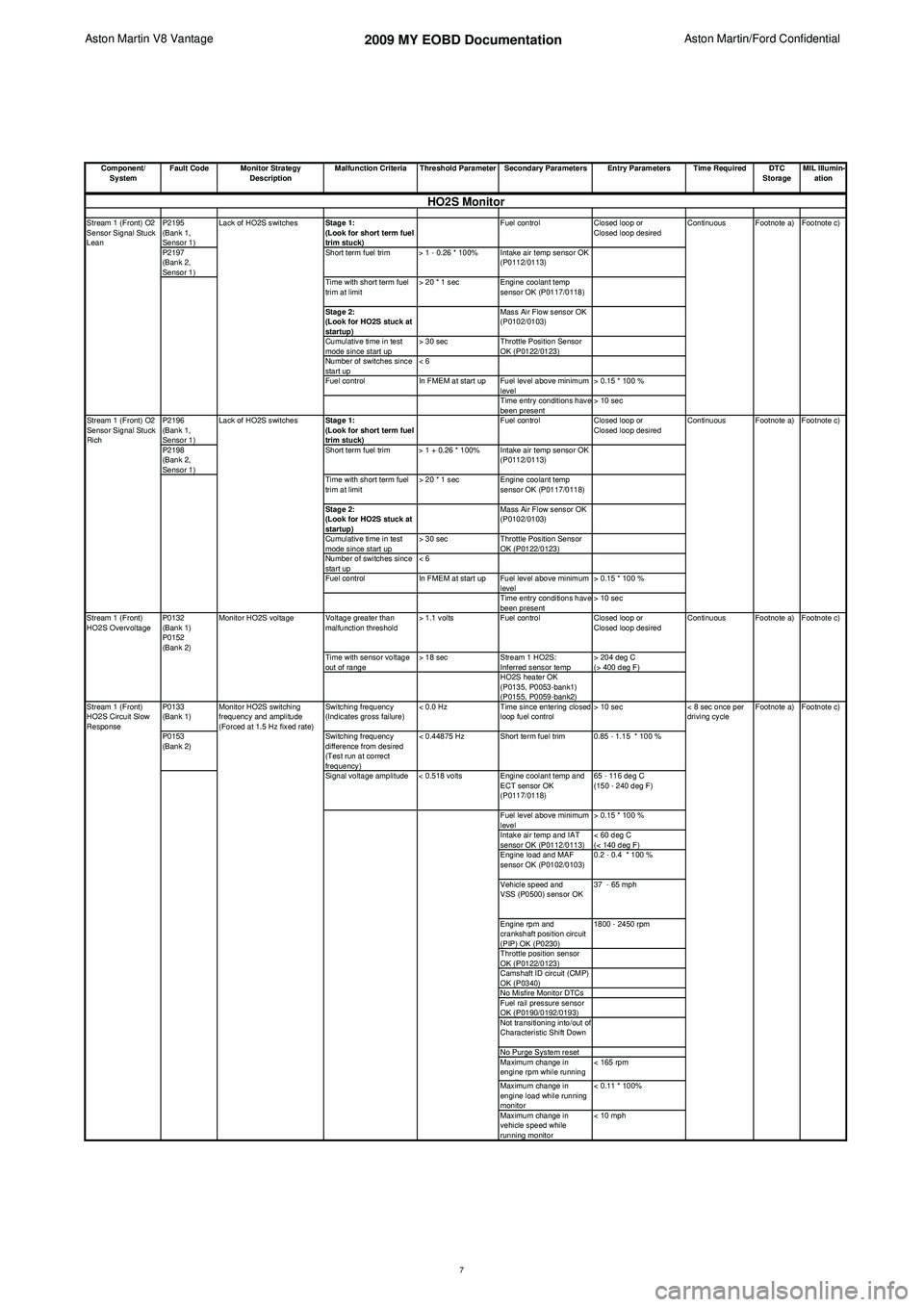
Aston Martin V8 Vantage 2009 MY EOBD DocumentationAston Martin/Ford Confidential
Component/ System Fault Code Monitor Strategy
Description Malfunction Criteria Threshold Parameter Secondary Parameters Entry Parameters Time Required DTC
StorageMIL Illumin-
ation
P2195
(Bank 1,
Sensor 1) Stage 1:
(Look for short term fuel
trim stuck) Fuel control Closed loop or
Closed loop desired
P2197
(Bank 2,
Sensor 1) Short term fuel trim > 1 - 0.26 * 100% Intake air temp sensor OK
(P0112/0113)
Time with short term fuel
trim at limit > 20 * 1 sec
Engine coolant temp
sensor OK (P0117/0118)
Stage 2:
(Look for HO2S stuck at
startup) Mass Air Flow sensor OK
(P0102/0103)
Cumulative time in test
mode since start up > 30 sec
Throttle Position Sensor
OK (P0122/0123)
Number of switches since
start up < 6
Fuel control In FMEM at start up Fuel level above minimum
level > 0.15 * 100 %
Time entry conditions have
been present > 10 sec
P2196
(Bank 1,
Sensor 1) Stage 1:
(Look for short term fuel
trim stuck) Fuel control
Closed loop or
Closed loop desired
P2198
(Bank 2,
Sensor 1) Short term fuel trim > 1 + 0.26 * 100% Intake air temp sensor OK
(P0112/0113)
Time with short term fuel
trim at limit > 20 * 1 sec
Engine coolant temp
sensor OK (P0117/0118)
Stage 2:
(Look for HO2S stuck at
startup) Mass Air Flow sensor OK
(P0102/0103)
Cumulative time in test
mode since start up > 30 sec
Throttle Position Sensor
OK (P0122/0123)
Number of switches since
start up < 6
Fuel control In FMEM at start up Fuel level above minimum
level > 0.15 * 100 %
Time entry conditions have
been present > 10 sec
Voltage greater than
malfunction threshold > 1.1 volts
Fuel control Closed loop or
Closed loop desired
Time with sensor voltage
out of range > 18 sec
Stream 1 HO2S:
Inferred sensor temp > 204 deg C
(> 400 deg F)
HO2S heater OK
(P0135, P0053-bank1)
(P0155, P0059-bank2)
P0133
(Bank 1) Switching frequency
(Indicates gross failure)< 0.0 Hz
Time since entering closed
loop fuel control > 10 sec
P0153
(Bank 2) Switching frequency
difference from desired
(Test run at correct
frequency)< 0.44875 Hz Short term fuel trim 0.85 - 1.15 * 100 %
Signal voltage amplitude < 0.518 volts Engine coolant temp and ECT sensor OK
(P0117/0118)65 - 116 deg C
(150 - 240 deg F)
Fuel level above minimum
level > 0.15 * 100 %
Intake air temp and IAT
sensor OK (P0112/0113) < 60 deg C
(< 140 deg F)
Engine load and MAF
sensor OK (P0102/0103) 0.2 - 0.4 * 100 %
Vehicle speed and
VSS (P0500) sensor OK 37 - 65 mph
Engine rpm and
crankshaft position circuit
(PIP) OK (P0230) 1800 - 2450 rpm
Throttle position sensor
OK (P0122/0123)
Camshaft ID circuit (CMP)
OK (P0340)
No Misfire Monitor DTCs
Fuel rail pressure sensor
OK (P0190/0192/0193)
Not transitioning into/out of
Characteristic Shift Down
No Purge System reset
Maximum change in
engine rpm while running
it
< 165 rpm
Maximum change in
engine load while running
monitor < 0.11 * 100%
Maximum change in
vehicle speed while
running monitor < 10 mphContinuous
Footnote a)
Footnote a)
Monitor HO2S voltage Footnote a) Footnote c)
Stream 1 (Front)
HO2S Overvoltage
< 8 sec once per
driving cycle
Stream 1 (Front)
HO2S Circuit Slow
Response Monitor HO2S switching
frequency and amplitude
(Forced at 1.5 Hz fixed rate)
P0132
(Bank 1)
P0152
(Bank 2)
Continuous Footnote a) Footnote c)Footnote c)
Continuous
Stream 1 (Front) O2
Sensor Signal Stuck
Lean
Lack of HO2S switches
Lack of HO2S switches
HO2S Monitor
Footnote c)
Stream 1 (Front) O2
Sensor Signal Stuck
Rich
7
Page 897 of 947

Aston Martin V8 Vantage 2009 MY EOBD DocumentationAston Martin/Ford Confidential
Component/ System Fault Code Monitor Strategy
Description Malfunction Criteria Threshold Parameter Secondary Parameters Entry Parameters Time Required DTC
StorageMIL Illumin-
ation
Vehicle speed VSS
(P0500) sensor OK
Throttle position sensor
TPS OK (P0122/0123)
Vehicle speed and TPS in
range VSS<30mph OR
TPS>5.27deg (60cnts)
Battery Voltage 11< Voltage <18
SAIR not commanded >3 seconds
Time with fault >5 seconds
MAF1+MAF2
(0.35*estimate) Vehicle speed VSS
(P0500) sensor OK
MAF1< 0.5*estimate -
max (0.5*30.23g/sec)
OR (0.35*
(0.5*estimate)) Throttle position sensor
TPS OK (P0122/0123)
Vehicle speed and TPS in
range
VSS<30mph OR
TPS>5.27deg (60cnts)
Battery Voltage 11< Voltage <18
SAIR not commanded >3 seconds
Time with fault >5 seconds
Sensor signal voltage < 0.024 volts (0g/sec) Time since last PIP signal (Engine not stalled)< 150 msec
Fault filter routine > 1 sec
Sensor signal voltage > 4.88 volts (293g/sec) Time since last PIP signal (Engine not stalled)< 150 msec
Fault filter routine > 1 sec MAF1+MAF2
(0.35*estimate)Vehicle speed VSS
(P0500) sensor OK
MAF1< 0.5*estimate -
max (0.5*30.23g/sec) Throttle position sensor
TPS OK (P0122/0123)
MAF2< 0.5*estimate -
max (0.5*30.23g/sec)
OR (0.35*
(0.5*estimate)) Vehicle speed and TPS in
range
VSS<30mph OR
TPS>5.27deg (60cnts)
Battery Voltage 11< Voltage <18
SAIR not commanded >3 seconds
Time with fault >5 seconds
Vehicle speed VSS
(P0500) sensor OK
Throttle position sensor
TPS OK (P0122/0123)
Vehicle speed and TPS in
range VSS<30mph OR
TPS>5.27deg (60cnts)
Battery Voltage 11< Voltage <18
SAIR not commanded >3 seconds
Time with fault >5 seconds
MAF1+MAF2
(0.35*estimate) Vehicle speed VSS
(P0500) sensor OK
MAF2< 0.5*estimate -
max (0.5*30.23g/sec)
OR (0.35*
(0.5*estimate)) Throttle position sensor
TPS OK (P0122/0123)
Vehicle speed and TPS in
range
VSS<30mph OR
TPS>5.27deg (60cnts)
Battery Voltage 11< Voltage <18
SAIR not commanded >3 seconds
Time with fault >5 seconds
Sensor signal voltage < 0.024 volts (0g/sec) Time since last PIP signal (Engine not stalled)< 150 msec
Fault filter routine > 1 sec
Sensor signal voltage > 4.88 volts (293g/sec) Time since last PIP signal (Engine not stalled)< 150 msec
Fault filter routine > 1 sec MAF1+MAF2
(0.35*estimate)Vehicle speed VSS
(P0500) sensor OK
MAF1< 0.5*estimate -
max (0.5*30.23g/sec)
OR (0.35*
(0.5*estimate)) Throttle position sensor
TPS OK (P0122/0123)
MAF2< 0.5*estimate -
max (0.5*30.23g/sec)
OR (0.35*
(0.5*estimate)) Vehicle speed and TPS in
range
VSS<30mph OR
TPS>5.27deg (60cnts)
Battery Voltage 11< Voltage <18
SAIR not commanded >3 seconds
Time with fault >5 seconds
P010F
(MAFA/B
Correlation) Rationality Check
MAF codes raised P0100,P0101,P0104,
P010A,P010B,P010ETime with fault
>5 secondsComprehensive Component Monitor
MAF2 voltage < 0.024
(0g/sec) Continuous
P0100 (MAF A
Airpath) Rationality Check - Compares
measured MAF vs modelled
airflow MAF1 vs MAF2 low airflow
Circuit Check
P0103 (High) MAF1< 0.5*estimate -
max (0.5*30.23g/sec)
OR (0.35*
(0.5*estimate))
MAF1+MAF2 not equal to
estimate AND MAF1 vs
MAF2 low airflow
MAF Sensor Input
Circuit Check
P0104
(Backflow) Rationality Check
P0101 (MAF A
Range)
Rationality Check - Compares
measured MAF vs modelled
airflow
P010E
Backflow) Rationality Check
P0102 (Low)
MAF1 voltage < 0.024
(0g/sec)
P010A (MAF B
Airpath)
P010B MAF B
Range) Rationality Check - Compares
measured MAF vs modelled
airflow
Rationality Check - Compares
measured MAF vs modelled
airflow
MAF1+MAF2 not equal to
estimate AND MAF2 vs
MAF1 low airflow
MAF2 vs MAF1 low airflow MAF2< 0.5*estimate -
max (0.5*30.23g/sec)
OR (0.35*
(0.5*estimate)) Footnote a)
MAF1+MAF2 not equal to
estimate AND MAF1 & 2
do not equal estimate.
MAF2 voltage low.
P010C (Low) Circuit Check
Circuit Check
P010D (High) MAF1+MAF2 not equal to
estimate AND MAF1 & 2
do not equal estimate.
MAF1 voltage low.
Footnote c)
9